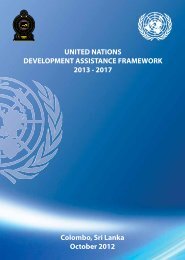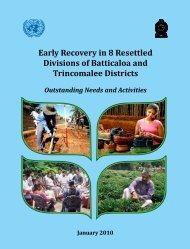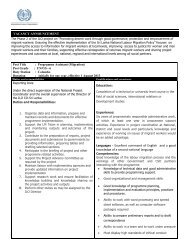Sri Lanka Human Development Report 2012.pdf
Sri Lanka Human Development Report 2012.pdf
Sri Lanka Human Development Report 2012.pdf
You also want an ePaper? Increase the reach of your titles
YUMPU automatically turns print PDFs into web optimized ePapers that Google loves.
The Ministry of Health in association with the Ministry of<br />
Finance and other relevant entities should develop a health<br />
strategy that identifies appropriate actions and resources<br />
to reduce health disparities and contain emerging diseases.<br />
Adequate measures to keep medical personnel in rural and<br />
conflict-affected areas could include incentives as well as<br />
a re-examination of the system of allocating personnel so<br />
they are better linked to the facilities they serve.<br />
Health care in <strong>Sri</strong> <strong>Lanka</strong> is free, but limited in the breadth<br />
of coverage across different diseases, and quality of service.<br />
This explains why out-of-pocket expenditure is increasing.<br />
It re-emphasizes the need to prioritize and streamline<br />
public provision of health care, so that essential and<br />
emergency services are easily accessible to all population<br />
groups.<br />
Make education more inclusive and relevant to<br />
the demands of the labour market<br />
The Government is the principal supplier of education<br />
at all levels: primary, junior secondary, upper secondary,<br />
collegiate and tertiary. Most students have access up to<br />
the junior secondary cycle, but it falls off progressively<br />
with higher levels of education. Another challenge is the<br />
mismatch between the skills provided by the education<br />
system and those demanded by the labour market. Quality<br />
varies across districts and sectors, but is poorest on the<br />
estates, in conflict-affected areas and in remote locations.<br />
While access to compulsory education is high, the<br />
country needs special measures to extend education to the<br />
most vulnerable groups (see Table 4.5 for details of net<br />
enrolment rates). These include children with disabilities,<br />
children who need special educational facilities, or<br />
children who come from broken families or very poor<br />
backgrounds. Efforts are being made to help such children<br />
through the non-formal education unit in the Ministry of<br />
Education. But initiatives like this need to be scaled up.<br />
Aside from more physical facilities, more trained teachers<br />
are required, vulnerable children need to be identified, and<br />
the overall drive for inclusion needs to be more targeted<br />
and sustained.<br />
The Ministry of Education and Ministry of Higher<br />
Education could undertake a stocktaking exercise to<br />
identify problems that are nationwide and more localized.<br />
Issues that demand immediate action include changing<br />
school curricula to meet the demands of the labour market<br />
in a modern, competitive economy; an increase in the<br />
supply of teachers in Science, English, Mathematics and<br />
Information Technology; an expansion of the capacity and<br />
quality of tertiary educational facilities; and strengthened<br />
governance structures to ensure adaptability and flexibility,<br />
monitoring of programmes, the attainment of desired<br />
outcomes, and the identification of problems as they<br />
emerge. Programmes are in place to improve schools in<br />
conflict-affected areas and on estates, and the outcomes of<br />
these programmes are regularly monitored. Such initiatives<br />
are commendable and should be continued. They need<br />
to be closely monitored to ensure that desired results are<br />
obtained in a timely manner and national education goals<br />
are achieved.<br />
The Ministry of Education could estimate the cost of the<br />
effort to upgrade education. This could reveal resource<br />
constraints that may necessitate wider private sector<br />
participation. While the private sector is already engaged<br />
in providing education at all levels, it must abide by<br />
national goals for education. A system of standards and<br />
regulations could be coupled with mechanisms to channel<br />
feedback to the Ministry of Education and Parliament,<br />
to monitor compliance and to correct anomalies. Giving<br />
schools more authority to raise funds, under stipulated<br />
conditions, could also bring more resources to education.<br />
Develop and implement targeted employment<br />
policies and foster opportunities for better<br />
livelihoods<br />
At less than 5 percent in 2011, <strong>Sri</strong> <strong>Lanka</strong>’s overall<br />
unemployment rate is impressive. But job creation has<br />
lagged considerably behind robust economic growth, with<br />
the number of employed growing at only 1.5 percent per<br />
year on average from 2000 to 2010, compared to an average<br />
real GDP growth rate of just below 5 percent. Jobs that<br />
follow nationally established guidelines for conditions of<br />
employment and provision of social security are limited.<br />
122<br />
sri lanka <strong>Human</strong> <strong>Development</strong> report 2012






